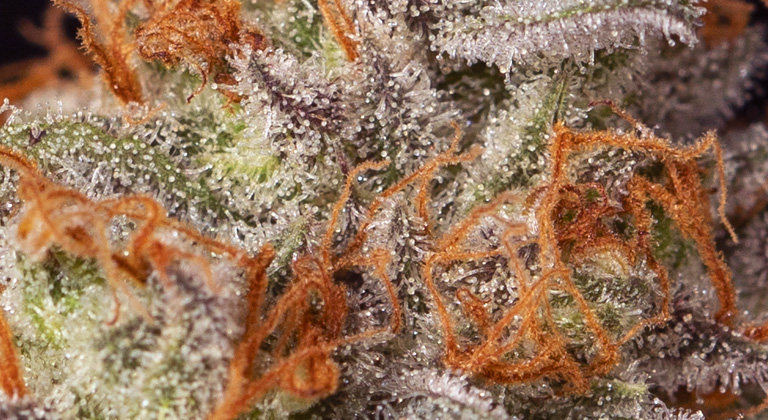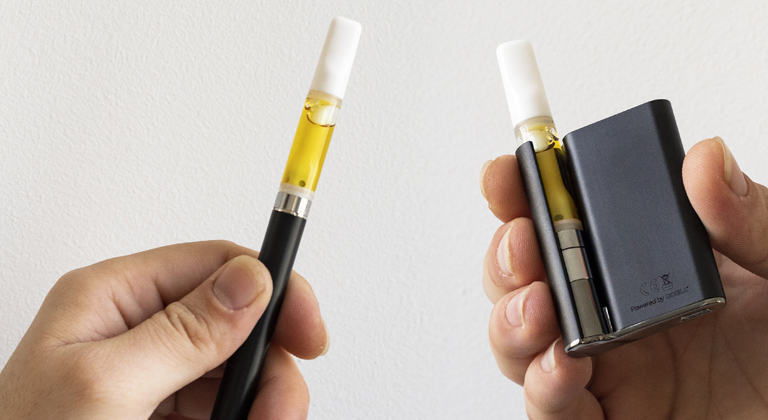Have you ever wondered why some cannabis strains smell like mint? Or what is the terpene responsible for this aroma? In this post, you will discover what menthol is and what it is used for, as well as some strains rich in this compound and their beneficial properties.
What is menthol?
Menthol is a cyclic monoterpene known for its refreshing aroma which is naturally present in various plant species.
As you might have guessed from its name, it’s one of the main terpenes in mint. Thanks to all its properties, this terpene is used in multiple products in the pharmaceutical, cosmetic, and food industries.
While menthol isn’t one of the main terpenes of cannabis (i.e., those commonly found in greater quantities in its aromatic profile), menthol is actually present in considerable amounts in some strains. For this reason, some cannabis strains have that fresh touch reminiscent of mint, which along with other terpenes like Limonene or Myrcene, for instance, can create a symphony of complex flavors that’s hard to match.
Main characteristics and curiosities of menthol
This terpene is an organic compound with the molecular formula C10H20O. Its chemical structure allows it to interact with the cold sensory receptors, producing a refreshing sensation. This curious mechanism occurs because menthol acts on the TRPM8 receptors in our bodies, which are responsible for sending the signal to the brain that “it is cold.”
Interestingly, these receptors are activated when there’s a drop in the temperature around us. However, some substances like menthol can “trick” these receptors, producing a sensation of freshness when there isn’t actually a real change in temperature.
Menthol can be obtained from natural sources (i.e., from plants like mint) or synthesized in labs for various commercial uses.

Where is menthol found in nature?
As mentioned earlier, menthol is a terpene found in varying proportions in different plants:
| Basil | Bitter melon | Cabbage | Coconut | Mint |
| Water mint | Spearmint | Peppermint | Thistle | Guava |
| Lovage | Oregano | Peppermint | Field mint | Sage |
| Tea | Tarragon | Tomato | Elderberry | Cannabis |
| Sunflower |
Properties and Benefits of Menthol
Although menthol is responsible for the fresh touch of some cannabis strains, this compound doesn’t just add aroma and flavor but also provides functional properties which are useful for improving our well-being.
-
- Calming effect: In aromatherapy, menthol can help reduce stress and improve concentration.
- Local anesthetic and analgesic properties: Menthol is widely recognized for its local anesthetic and analgesic effects. As mentioned earlier, it interacts with cold-sensitive ion channels, such as the TRPM8 receptor, providing that well-known cooling sensation and relief from superficial pain. This makes it a common component in topical products designed to alleviate muscle and joint pain. Menthol is often used in sports-related topical products as it’s been shown to reduce the perception of effort during physical activity and to improve endurance in hot conditions.
- Some products for the relief of nasal congestion also contain menthol. While menthol doesn’t physically reduce congestion, its application provides a subjective sensation of relief in the respiratory passages.
- Antimicrobial properties: Some studies demonstrate that menthol is effective in combating certain bacterial and fungal strains, making it commonly used in oral hygiene products.
- Enhances cognitive performance: Recent studies suggest that inhaling menthol might positively stimulate the central nervous system. In one study conducted on rodents(5), a remarkable improvement in cognitive function was observed, which could be useful in treating Alzheimer’s disease. The study showed that the inhalation of menthol helped mice to improve their memory and brain function, including those with Alzheimer-like symptoms. This improvement seems related to a reduction in certain molecules (IL-1β and IL-6) in a region of the brain that influences decision-making and memory. However, when the mice’s sense of smell was blocked with a drug called methimazole, menthol’s positive effect disappeared. This suggests that the aroma of menthol plays a key role in the benefits observed in the brain.
The Role of Menthol in the Terpene Profile of Cannabis
Even though menthol isn’t one of the primary terpenes in cannabis, its presence in the profiles of some strains enhances both their sensory experience anfunctional effects.
When combined with other molecules like terpenes and cannabinoids, menthol contributes to the “entourage effect,” where the different compounds with their distinct properties produce a synergy that contributes to enhancing beneficial effects.
Which cannabis strains contain menthol?
The composition of cannabis includes a great number of terpenes. Beyond the primary terpenes, some strains have higher levels of menthol than others. Here are some examples of terpene profiles with higher levels of menthol:
- Mojito: This terpene profile produces an intense aroma and flavor that many describe as fresh, with notes of lime, mint, and chocolate. It provides stimulating effects which are ideal for improving mood.
- Blackberry Kush: This strain’s profile delivers a penetrating aroma and flavor, with sweet and earthy notes mixed with hints of berries. In addition, it produces relaxing sensations and can also help with stress relief.
- Dosidos: This profile produces an intense Kushy and earthy aroma and flavor with sweet, citrusy, and spicy notes of Diesel. It also helps produce feelings of relaxation, so it can be used at the end of the day to relieve stress and improve mood.

Frequently Asked Questions About Menthol
- Is menthol psychoactive?
No, menthol doesn’t produce any psychoactive effects. However, its refreshing sensation may influence the perception of the effects of cannabis. - Does menthol have any side effects?
In high doses, menthol may cause irritation on the skin and mucous membranes, so it should always be used in the right doses.
As you’ve seen in this article, menthol is a compound present in the terpene profile of cannabis that is useful for various applications. Its refreshing sensation and therapeutic properties make it a key ingredient in the formulation of numerous products, whether in the cosmetic, medicinal, food, or cannabis sector. This terpene, along with the wide variety of terpenes found in cannabis, is a crucial tool for those looking to innovate by creating products that are surprising both in terms of taste and effects.
- Almaraz L, Manenschijn JA, de la Peña E, Viana F. TRPM8. Handb Exp Pharmacol. 2014;222:547-79. doi: 10.1007/978-3-642-54215-2_22. PMID: 24756721.
- Hilfiger L, Triaux Z, Marcic C, Héberlé E, Emhemmed F, Darbon P, Marchioni E, Petitjean H, Charlet A. Anti-Hyperalgesic Properties of Menthol and Pulegone. Front Pharmacol. 2021 Nov 30;12:753873. doi: 10.3389/fphar.2021.753873. PMID: 34916937; PMCID: PMC8670501.
- Tomaselli S, Bertini F, Cifarelli A, Vignali A, Ragona L, Losio S. Antibacterial Properties of Polyurethane Foams Additivated with Terpenes from a Bio-Based Polyol. Molecules. 2023 Feb 18;28(4):1966. doi: 10.3390/molecules28041966. PMID: 36838954; PMCID: PMC9966847.
- Herro E, Jacob SE. Mentha piperita (peppermint). Dermatitis. 2010 Nov-Dec;21(6):327-9. PMID: 21144345.
- Casares N, Alfaro M, Cuadrado-Tejedor M, Lasarte-Cia A, Navarro F, Vivas I, Espelosin M, Cartas-Cejudo P, Fernández-Irigoyen J, Santamaría E, García-Osta A, Lasarte JJ. Improvement of cognitive function in wild-type and Alzheimer´s disease mouse models by the immunomodulatory properties of menthol inhalation or by depletion of T regulatory cells. Front Immunol. 2023 Apr 27;14:1130044. doi: 10.3389/fimmu.2023.1130044. PMID: 37187754; PMCID: PMC10175945.








